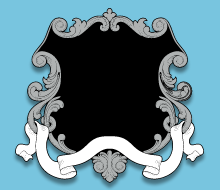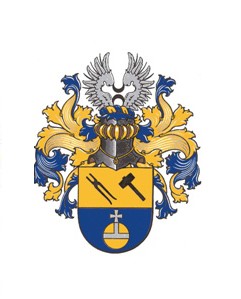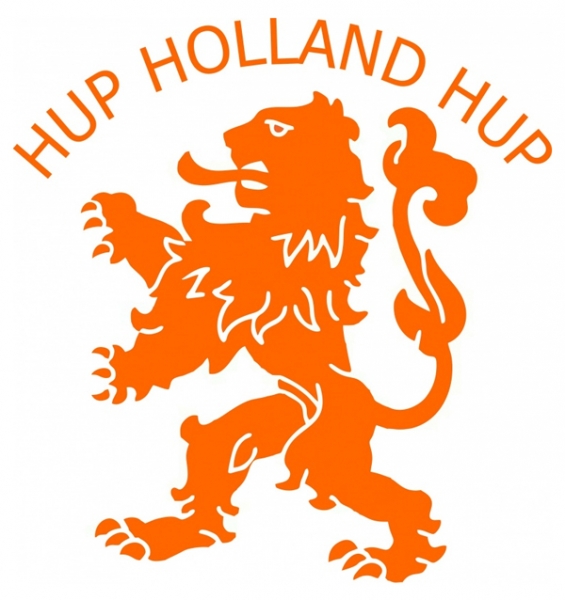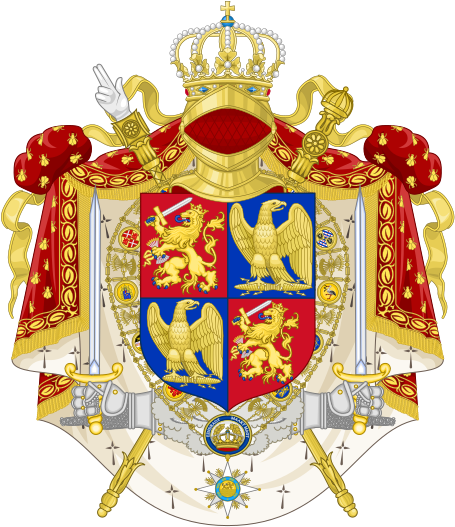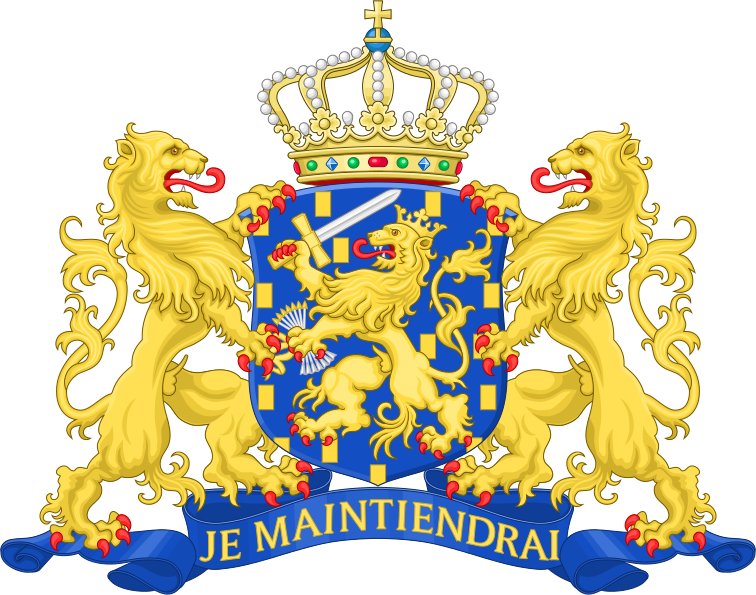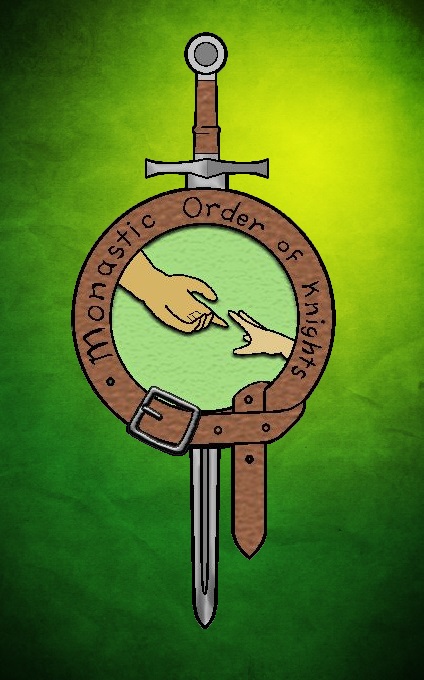Serenity- Heraldry and Heritage
Less
More
- Posts: 445
- Thank you received: 566
5 years 7 months ago #2333
by Serenity
Replied by Serenity on topic Serenity- Heraldry and Heritage
Lesson 1: History and Composition of the Heraldic Achievement
For the most part the content of this lesson was known to me , i was however surprised that women had their own shields , i like that , even though women were not commonly found on the battlefield a coat of arms is so much more that an identifying object in a war zone. The different kind of shields and compositions are fascinating and now i am studying my family history i see them everywhere , and when i see one ...i have to know the meaning of such works of art. Because many of them are.
I also like the simple ones that are more stylish , the one of our village is a lot different from the one they used in the past
This is the modern one
Village coat of arms of Gemert
Gemert weapon 1976.svg
Old weapon of Gemert from 1976 until the merger in 1997 used
Gemert weapon 1817.svg
Wapen van Gemert from 1817
Coat of arms of the German Order: , the coat of arms of Gemert van is derived
The weapon of Gemert concerns the village weapon of the North Brabant town of Gemert. The weapon consists of a silver shield with a black cross and a multi-leaf. The coat of arms of the Teutonic Order also contained a silver shield with black cross, it was derived from it.
this is the older one which is still in use for the more official matter and is more correct as the new one is metal on metal , which is not according to Heraldic rules
In gold a cross of silver, a heartshell of silver with an eagle of saber, the shield covered with a golden crown of three leaves and two pearls
It is derived from that of the Biezen chamber of the German Order, to which Gemert belonged. This room carried the cross of saber on silver, with the German eagle as the heartshell. The arms of the cross laden with a Jerusalem cross, also called crutch cross. The Order established a bank of ships, which carried a seal with a cross and an eagle, of which variants from the fourteenth and seventeenth centuries are known. It is suspected that the cross is originally black in color. Placing a silver on gold is usually heraldically incorrect and is only considered correct with papal weapons. Other weapons with such a use of color are counted among the riddle weapons.
I want to especially thank Jzen for these lessons , he put a lot of work in it and is helping me with my own coat of arms
For the most part the content of this lesson was known to me , i was however surprised that women had their own shields , i like that , even though women were not commonly found on the battlefield a coat of arms is so much more that an identifying object in a war zone. The different kind of shields and compositions are fascinating and now i am studying my family history i see them everywhere , and when i see one ...i have to know the meaning of such works of art. Because many of them are.
I also like the simple ones that are more stylish , the one of our village is a lot different from the one they used in the past
This is the modern one
Village coat of arms of Gemert
Gemert weapon 1976.svg
Old weapon of Gemert from 1976 until the merger in 1997 used
Gemert weapon 1817.svg
Wapen van Gemert from 1817
Coat of arms of the German Order: , the coat of arms of Gemert van is derived
The weapon of Gemert concerns the village weapon of the North Brabant town of Gemert. The weapon consists of a silver shield with a black cross and a multi-leaf. The coat of arms of the Teutonic Order also contained a silver shield with black cross, it was derived from it.
this is the older one which is still in use for the more official matter and is more correct as the new one is metal on metal , which is not according to Heraldic rules
In gold a cross of silver, a heartshell of silver with an eagle of saber, the shield covered with a golden crown of three leaves and two pearls
It is derived from that of the Biezen chamber of the German Order, to which Gemert belonged. This room carried the cross of saber on silver, with the German eagle as the heartshell. The arms of the cross laden with a Jerusalem cross, also called crutch cross. The Order established a bank of ships, which carried a seal with a cross and an eagle, of which variants from the fourteenth and seventeenth centuries are known. It is suspected that the cross is originally black in color. Placing a silver on gold is usually heraldically incorrect and is only considered correct with papal weapons. Other weapons with such a use of color are counted among the riddle weapons.
I want to especially thank Jzen for these lessons , he put a lot of work in it and is helping me with my own coat of arms
The following user(s) said Thank You: Wescli Wardest, jzen
Please Log in or Create an account to join the conversation.
Less
More
- Posts: 445
- Thank you received: 566
5 years 7 months ago #2334
by Serenity
Replied by Serenity on topic Serenity- Heraldry and Heritage
Lesson 2: Styles of Escutcheon
The Escutcheon is the overall form of the coat of arms , we can see from the shape that it either belongs to a common , a nobel or even a woman. The basic shapes more or less stay the same but you can see in many coats of arms that wings , helmets , lions and credo’s are added to elaborate and make it stand out more.
On this website there are lots of different shapes , what they have in common mostly is that they are broader on the top , this i think because it used to be a literal shield www.fleurdelis.com/shields.htm
Some of them are really pretty , and some of them really serve no other purpose than be practical
The Escutcheon is the overall form of the coat of arms , we can see from the shape that it either belongs to a common , a nobel or even a woman. The basic shapes more or less stay the same but you can see in many coats of arms that wings , helmets , lions and credo’s are added to elaborate and make it stand out more.
On this website there are lots of different shapes , what they have in common mostly is that they are broader on the top , this i think because it used to be a literal shield www.fleurdelis.com/shields.htm
Some of them are really pretty , and some of them really serve no other purpose than be practical
The following user(s) said Thank You: Wescli Wardest, jzen
Please Log in or Create an account to join the conversation.
Less
More
- Posts: 445
- Thank you received: 566
5 years 7 months ago - 5 years 7 months ago #2368
by Serenity
Replied by Serenity on topic Serenity- Heraldry and Heritage
Lesson 3: Color in Heraldry
We briefly went over some different shapes that come up in heraldry and now we will talk about colors. First thing we must discuss before getting into the different colors and meanings is what is considered the most basic rule in all of heraldry: The Rule of Tincture.
The Rule of Tincture states that:
Metal should not be placed on metal nor colour on colour.
This rule of Tincture is one of the more important rules in Heraldry , but also the most forgotten or ignored ones is seems , even in the shields of our village , metals are placed on metals and if you go on the internet you can find a few more offences of this Rule.
The Encyclopædia Britannica has a feature on this as well , i remember reading it and forgetting about it , until now , 25 years later , funny how things come back to you. I used to be in to Coats of Arms when i was younger but kind of lost interest in History in Knighthood and other European folk stories...Until i moved to Gemert , this town is breathing and living History and i am blessed that Jzen is putting these nice Lessons here so i can make a nice impression at the History Guild here , i am thinking of joining the Archives , they are people with a lot of knowledge and they pass history a long , a very worthy cause if you ask me , but enough about me..haha
I would also like you to look at this PDF a fun guide through Heraldry for children ages 9 to 13 but i found it very enjoyable and informative. www.gg.ca/pdf/HeraldryEdukit.pdf
Coming back to the colours and furs and such,i have already tried to be very specific about those rules and i would love to make my own coat of arms but i sincerely lack the skills for making a digital one , Jzen is making it for me , i am thinking of making one of cloth and sticking it on a Escutcheon and see what the outcome is when we can compare them. I am much better with textile than with graphic design lol
As you begin to think about colors for your coat of arms, think about the traits you exhibit, or the traits that you find important to exhibit.
What virtues do you associate with yourself?
caring
courage
diligence
forgiveness
perseverance
service
truthfulness
responsibility
helpfulness
What virtues would someone close to you that knows you well associate with you
Service
Courage
Perseverance
Caring
Responsibility
We briefly went over some different shapes that come up in heraldry and now we will talk about colors. First thing we must discuss before getting into the different colors and meanings is what is considered the most basic rule in all of heraldry: The Rule of Tincture.
The Rule of Tincture states that:
Metal should not be placed on metal nor colour on colour.
This rule of Tincture is one of the more important rules in Heraldry , but also the most forgotten or ignored ones is seems , even in the shields of our village , metals are placed on metals and if you go on the internet you can find a few more offences of this Rule.
The Encyclopædia Britannica has a feature on this as well , i remember reading it and forgetting about it , until now , 25 years later , funny how things come back to you. I used to be in to Coats of Arms when i was younger but kind of lost interest in History in Knighthood and other European folk stories...Until i moved to Gemert , this town is breathing and living History and i am blessed that Jzen is putting these nice Lessons here so i can make a nice impression at the History Guild here , i am thinking of joining the Archives , they are people with a lot of knowledge and they pass history a long , a very worthy cause if you ask me , but enough about me..haha
I would also like you to look at this PDF a fun guide through Heraldry for children ages 9 to 13 but i found it very enjoyable and informative. www.gg.ca/pdf/HeraldryEdukit.pdf
Coming back to the colours and furs and such,i have already tried to be very specific about those rules and i would love to make my own coat of arms but i sincerely lack the skills for making a digital one , Jzen is making it for me , i am thinking of making one of cloth and sticking it on a Escutcheon and see what the outcome is when we can compare them. I am much better with textile than with graphic design lol
As you begin to think about colors for your coat of arms, think about the traits you exhibit, or the traits that you find important to exhibit.
What virtues do you associate with yourself?
caring
courage
diligence
forgiveness
perseverance
service
truthfulness
responsibility
helpfulness
What virtues would someone close to you that knows you well associate with you
Service
Courage
Perseverance
Caring
Responsibility
Last edit: 5 years 7 months ago by Serenity.
The following user(s) said Thank You: jzen
Please Log in or Create an account to join the conversation.
Less
More
- Posts: 445
- Thank you received: 566
5 years 7 months ago #2369
by Serenity
Replied by Serenity on topic Serenity- Heraldry and Heritage
Lesson 4- Divisions of the Field
Now that we have discussed colors of the field, I wanted to touch on divisions of the field. This is the manner in which an Escutcheon is divided up in order to convey information. It creates mini fields inside the overall field.
In the divisions of the Fields we show information that we want to display in order of importance , mostly we try to display and share our families great achievments or simply emphasise their virtues , i can honestly say that your shield can tell others a lot about you , or , nothing at all. A coat of arms that is only made to impress and not reflect the real values of you or your family is just a decorative piece and nothing more in my opinion , and i know it's not a popular one
As you become more familiar with these different ways of dividing up your shield, think about how much information you want to share.
Do you come from a noble line and you want to share their arms as part of yours or different virtues that you find important enough to display as your own?
No not really , but i find nobility overrated anyhow it's usaully asholes desperately hanging on to power and money and not being of much use to fight poverty etc..., i think we are in this life to be the best person one can be , the Faber family for instance is Nobel in virtue of charity and service , the Wilkin family is noble in it's way it renounced nobility because of their principles and the Thomassen family are excellent tradesmen , i think i want them equally represented and i have found it in the credo , Servicio , Cura , Respetto, to serve to care and to respect , values that i think are vital to a Jedi and any other decent human being. It's not so much information as such that i would like to share as much as a family history merged into a shield that i can carry and explain to others where i and it stems from. Sharing my values as i have been tought and have learned through my family.
Begin thinking about how you would like to divide up your field and what story you want your arms to tell. Share these thoughts in your journal.
I have chosen a female Lozenge shield which is ideal for dividing into 4 parts but not more , it would look doll like then , divided by metal lines etc And it represents the feminine part of me and my family.
Now that we have discussed colors of the field, I wanted to touch on divisions of the field. This is the manner in which an Escutcheon is divided up in order to convey information. It creates mini fields inside the overall field.
In the divisions of the Fields we show information that we want to display in order of importance , mostly we try to display and share our families great achievments or simply emphasise their virtues , i can honestly say that your shield can tell others a lot about you , or , nothing at all. A coat of arms that is only made to impress and not reflect the real values of you or your family is just a decorative piece and nothing more in my opinion , and i know it's not a popular one
As you become more familiar with these different ways of dividing up your shield, think about how much information you want to share.
Do you come from a noble line and you want to share their arms as part of yours or different virtues that you find important enough to display as your own?
No not really , but i find nobility overrated anyhow it's usaully asholes desperately hanging on to power and money and not being of much use to fight poverty etc..., i think we are in this life to be the best person one can be , the Faber family for instance is Nobel in virtue of charity and service , the Wilkin family is noble in it's way it renounced nobility because of their principles and the Thomassen family are excellent tradesmen , i think i want them equally represented and i have found it in the credo , Servicio , Cura , Respetto, to serve to care and to respect , values that i think are vital to a Jedi and any other decent human being. It's not so much information as such that i would like to share as much as a family history merged into a shield that i can carry and explain to others where i and it stems from. Sharing my values as i have been tought and have learned through my family.
Begin thinking about how you would like to divide up your field and what story you want your arms to tell. Share these thoughts in your journal.
I have chosen a female Lozenge shield which is ideal for dividing into 4 parts but not more , it would look doll like then , divided by metal lines etc And it represents the feminine part of me and my family.
The following user(s) said Thank You: Wescli Wardest, jzen
Please Log in or Create an account to join the conversation.
- Wescli Wardest
-
- Offline
- Meister
-
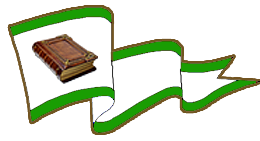
Less
More
- Posts: 882
- Thank you received: 1112
5 years 6 months ago #2370
by Wescli Wardest
Replied by Wescli Wardest on topic Serenity- Heraldry and Heritage
I can't wait to see it.

Please Log in or Create an account to join the conversation.
Less
More
- Posts: 445
- Thank you received: 566
5 years 6 months ago #2371
by Serenity
Neither can i
Replied by Serenity on topic Serenity- Heraldry and Heritage
Wescli Wardest wrote: I can't wait to see it.
Neither can i
The following user(s) said Thank You: jzen
Please Log in or Create an account to join the conversation.
Less
More
- Posts: 445
- Thank you received: 566
5 years 6 months ago #2373
by Serenity
Replied by Serenity on topic Serenity- Heraldry and Heritage
Lesson 5: Ordinaries and Subordinaries
Now that we have discussed divisions of the field, there are some basic geometric shapes that find their place on escutcheons along the boundaries of divisions. These can be classified into two main categories: Ordinaries and Sub Ordinaries. Let's talk about each.
The website www.houseofnames.com/blogs/ordinaries has some nice additions to this lesson , the most important thing i got away from this lesson is that Sub Ordinaires do not cover the whole shield they only cover a geometric , symmetric part of the field and from most shields i know they are framed in a or or argent compartiment. It's a symmetric whole of information being displayed with some very complicated rules at times although there is logic to them
Now that we have discussed divisions of the field, there are some basic geometric shapes that find their place on escutcheons along the boundaries of divisions. These can be classified into two main categories: Ordinaries and Sub Ordinaries. Let's talk about each.
The website www.houseofnames.com/blogs/ordinaries has some nice additions to this lesson , the most important thing i got away from this lesson is that Sub Ordinaires do not cover the whole shield they only cover a geometric , symmetric part of the field and from most shields i know they are framed in a or or argent compartiment. It's a symmetric whole of information being displayed with some very complicated rules at times although there is logic to them
The following user(s) said Thank You: Wescli Wardest, jzen
Please Log in or Create an account to join the conversation.
Less
More
- Posts: 445
- Thank you received: 566
5 years 6 months ago #2376
by Serenity
Replied by Serenity on topic Serenity- Heraldry and Heritage
Lesson 6: Diminutives
This is an additional element to talk about that ties in with the previous lesson. What happens when someone wants to use two or more ordinaries on a coat of arms? This style is called a Diminutive and can be an interesting way to add an attractive appearance to your escutcheon.
The Diminutive is mostly seen on coats of arms that have a lot to tell you obviously , as i am digging deeper into this i realise that what i would want as a coat of arms is already and has already been in my head a long time , a wonderful mix of experience , history , lesson and message..for my child , grandchildren and others who are interested. I have been looking up the Diminutive and i have see some very beautiful shields , but the one that always speaks the most to me is the Diminutive of the cross , this also is the case with the coat of arms of the village where i live.
The Egan coat of arms has a very unusual Diminutive of the cross coadb.com/surnames/egan-arms.html
Where as the Faber family coat of arms has a Pallet with a typical band half the width of the pale.
Although i like the Egan coat of arms there is something about a more simple form
Its a nice study , its so in depth and i find myself looking at coat of arms on building trying to figure out how they are build up and what the meanings are
This is an additional element to talk about that ties in with the previous lesson. What happens when someone wants to use two or more ordinaries on a coat of arms? This style is called a Diminutive and can be an interesting way to add an attractive appearance to your escutcheon.
The Diminutive is mostly seen on coats of arms that have a lot to tell you obviously , as i am digging deeper into this i realise that what i would want as a coat of arms is already and has already been in my head a long time , a wonderful mix of experience , history , lesson and message..for my child , grandchildren and others who are interested. I have been looking up the Diminutive and i have see some very beautiful shields , but the one that always speaks the most to me is the Diminutive of the cross , this also is the case with the coat of arms of the village where i live.
The Egan coat of arms has a very unusual Diminutive of the cross coadb.com/surnames/egan-arms.html
Where as the Faber family coat of arms has a Pallet with a typical band half the width of the pale.
Although i like the Egan coat of arms there is something about a more simple form
Its a nice study , its so in depth and i find myself looking at coat of arms on building trying to figure out how they are build up and what the meanings are
The following user(s) said Thank You: Wescli Wardest, jzen
Please Log in or Create an account to join the conversation.
Less
More
- Posts: 445
- Thank you received: 566
5 years 6 months ago #2377
by Serenity
Replied by Serenity on topic Serenity- Heraldry and Heritage
Lesson 7: Charges Part 1 - Lions
Charges are emblems that occupy part of the escutcheon. Technically, Ordinaries and Subordinaries are considered charges based on specific geometric shapes. What the next few lessons will cover are categories of Charges that are popular in Heraldic decoration. Charges carry meaning and symbolism and can mean different things based on how they are displayed. As you go through these lessons think about what the positioning means, and what applies to you. This first lesson will cover the use of the Lion, one of the most popular Heraldic Charges in use.
Lions !!! Anyone who ever watched football ( soccer) and ever saw the Dutch team knows our Dutch Lion. It's derived of the Netherlands coat of arms of the Kingdom of the Netherlands , children grow up with the Dutch Lion , the courageous animal that protects what is his. A very Rampant lion , it's a lion ready to strike , ready for combat , or in soccer terms , always ready to attack and win haha
The coat of arms of the Kingdom of the Netherlands was originally adopted in 1815 and later modified in 1907. The arms are a composite of the arms of the former Dutch Republic and the arms of the House of Nassau, it features a checkered shield with a lion grasping a sword in one hand and a bundle of arrows in the other and is the heraldic symbol of the monarch (King Willem-Alexander) and the country. The monarch uses a version of the arms with a mantle (Dutch: Koninklijk wapen) while the government of the Netherlands uses a smaller version without the mantle (cloak) or the pavilion, sometimes only the shield and crown are used (Dutch: Rijkswapen). The components of the coats of arms were regulated by Queen Wilhelmina in a royal decree of 10 July 1907, affirmed by Queen Juliana in a royal decree of 23 April 1980.
The feature of the Lion holding objects in his hands like a sword or arrows is just an addition to the Rampant Lion , here you can see the Lion being supported by two other Lions , they are not armed and mainly for support. Sejant Rampant.
Charges are emblems that occupy part of the escutcheon. Technically, Ordinaries and Subordinaries are considered charges based on specific geometric shapes. What the next few lessons will cover are categories of Charges that are popular in Heraldic decoration. Charges carry meaning and symbolism and can mean different things based on how they are displayed. As you go through these lessons think about what the positioning means, and what applies to you. This first lesson will cover the use of the Lion, one of the most popular Heraldic Charges in use.
Lions !!! Anyone who ever watched football ( soccer) and ever saw the Dutch team knows our Dutch Lion. It's derived of the Netherlands coat of arms of the Kingdom of the Netherlands , children grow up with the Dutch Lion , the courageous animal that protects what is his. A very Rampant lion , it's a lion ready to strike , ready for combat , or in soccer terms , always ready to attack and win haha
The coat of arms of the Kingdom of the Netherlands was originally adopted in 1815 and later modified in 1907. The arms are a composite of the arms of the former Dutch Republic and the arms of the House of Nassau, it features a checkered shield with a lion grasping a sword in one hand and a bundle of arrows in the other and is the heraldic symbol of the monarch (King Willem-Alexander) and the country. The monarch uses a version of the arms with a mantle (Dutch: Koninklijk wapen) while the government of the Netherlands uses a smaller version without the mantle (cloak) or the pavilion, sometimes only the shield and crown are used (Dutch: Rijkswapen). The components of the coats of arms were regulated by Queen Wilhelmina in a royal decree of 10 July 1907, affirmed by Queen Juliana in a royal decree of 23 April 1980.
The feature of the Lion holding objects in his hands like a sword or arrows is just an addition to the Rampant Lion , here you can see the Lion being supported by two other Lions , they are not armed and mainly for support. Sejant Rampant.
The following user(s) said Thank You: Wescli Wardest, jzen
Please Log in or Create an account to join the conversation.
Less
More
- Posts: 445
- Thank you received: 566
5 years 6 months ago #2390
by Serenity
Replied by Serenity on topic Serenity- Heraldry and Heritage
Lesson 8: Charges Part 2- Other Animals
Heraldry uses many different animals in the presentation of the coats of arms. Animals used can be real or mythical and have meanings associated with their usage. For this lesson, I'll be referencing Arthur Charles Fox-Davies and his 1909 work A Complete Guide to Heraldry , still considered the authoritative text on heraldry. Here are some of the most common categories of animals:
Beasts:
Animals are a grateful subject in Heraldry as they represent virtues better than a writing. Every animal has a different meaning and we add them to our crest to represent the family values. We start of with my favourite one because we usually don't represent our values with this stubborn animal , but yeah , in Heraldry it's a fine beast
Ass [donkey] = Patience and humility
Bear = Strength, cunning, ferocity in the protection of one's kindred
Beaver = Industry and perseverance
Boar = Bravery; fights to the death
Bull/Buffalo = Valour, bravery, generosity
Camel = Docility, patience, and perseverance
Cat = (Also Wildcat or Lynx) Liberty, vigilance, forecast, and courage
Deer = One who will not fight unless provoked; peace and harmony
Dog = Courage, vigilance, and loyalty , different dogs have additional meanings.
Elephant = Great strength, wit, longevity, happiness, royalty, good luck, and ambition
Fox = One who will use all that he/she may possess of wisdom and wit in his/her own defense
Horse = Readiness for all employments for king and country
Ram = Authority
Tiger = Fierceness and valour; resentment; dangerous if aroused
Wolf = Reward from perseverance in long sieges and/or hard industry
This list is by no means complete but these are the most common ones.
Mythical Beasts
Antelope = (heraldic) A mythical animal with the body of a stag, the tail of a unicorn, a tusk at the tip of the nose, tufts down the back of the neck, chest, and thighs (usually represented with two straight horns serrated on one side)
Allerion = (Mythical creature, similar to an eagle, but without beak or claws) Strength of will and authority of mind
Centaur = Eminence in the field of battle
Dragon = Valiant defender of treasure; valour and protection
Griffin = (Head, wings, and talons of an eagle with the body of a lion); Valour and death-defying bravery; vigilance
Unicorn = Extreme courage; virtue and strength
Hydra = (dragon with seven heads) Conquest of a very powerful enemy
Birds in Heraldry
The bird in our village crest looks like a squashed crow , i always wondered why they were so popular in crests but then again it used to be a very common bird.
Crow = Strategist in battle; watchful for friends; divine providence
Eagle with wings "displayed," = it signifies protection
Eagle with two heads = Conjoining of two forces
Fish
Fish are also very popular in Heraldry
Fish = A true, generous mind; virtuous for himself, not because of his heritage; also unity with Christ, spiritual nourishment
Reptiles
Although i don't commonly see reptiles in coat of arms the snake is the most represented one , it has different meanings all over the world and is usually shown in combination with wisdom. I also found a crest with a crocodile in it but i cannot seem to find the meaning behind it
Serpent/Snake/Lizard = Wisdom
Salamander = Protection
Tortoise = Invulnerability to attack
Cockatrice = (small serpent) Terror to all beholders
Insects
There is a good amount of good stuff on insects in Heraldry , i like them , especially the Butterflies , for me they represent beauty and vulnerability and transformation into one's full potential although in Heraldry that is not what they mean. Insects have varied meanings in Heraldry but the most common are
Ant = Great labour, wisdom, and providence in one's affairs
Bee = Efficient industry
Butterfly = Psyche or Soul
Source: the-red-thread.net/genealogy/heraldry.html
Heraldry uses many different animals in the presentation of the coats of arms. Animals used can be real or mythical and have meanings associated with their usage. For this lesson, I'll be referencing Arthur Charles Fox-Davies and his 1909 work A Complete Guide to Heraldry , still considered the authoritative text on heraldry. Here are some of the most common categories of animals:
Beasts:
Animals are a grateful subject in Heraldry as they represent virtues better than a writing. Every animal has a different meaning and we add them to our crest to represent the family values. We start of with my favourite one because we usually don't represent our values with this stubborn animal , but yeah , in Heraldry it's a fine beast
Ass [donkey] = Patience and humility
Bear = Strength, cunning, ferocity in the protection of one's kindred
Beaver = Industry and perseverance
Boar = Bravery; fights to the death
Bull/Buffalo = Valour, bravery, generosity
Camel = Docility, patience, and perseverance
Cat = (Also Wildcat or Lynx) Liberty, vigilance, forecast, and courage
Deer = One who will not fight unless provoked; peace and harmony
Dog = Courage, vigilance, and loyalty , different dogs have additional meanings.
Elephant = Great strength, wit, longevity, happiness, royalty, good luck, and ambition
Fox = One who will use all that he/she may possess of wisdom and wit in his/her own defense
Horse = Readiness for all employments for king and country
Ram = Authority
Tiger = Fierceness and valour; resentment; dangerous if aroused
Wolf = Reward from perseverance in long sieges and/or hard industry
This list is by no means complete but these are the most common ones.
Mythical Beasts
Antelope = (heraldic) A mythical animal with the body of a stag, the tail of a unicorn, a tusk at the tip of the nose, tufts down the back of the neck, chest, and thighs (usually represented with two straight horns serrated on one side)
Allerion = (Mythical creature, similar to an eagle, but without beak or claws) Strength of will and authority of mind
Centaur = Eminence in the field of battle
Dragon = Valiant defender of treasure; valour and protection
Griffin = (Head, wings, and talons of an eagle with the body of a lion); Valour and death-defying bravery; vigilance
Unicorn = Extreme courage; virtue and strength
Hydra = (dragon with seven heads) Conquest of a very powerful enemy
Birds in Heraldry
The bird in our village crest looks like a squashed crow , i always wondered why they were so popular in crests but then again it used to be a very common bird.
Crow = Strategist in battle; watchful for friends; divine providence
Eagle with wings "displayed," = it signifies protection
Eagle with two heads = Conjoining of two forces
Fish
Fish are also very popular in Heraldry
Fish = A true, generous mind; virtuous for himself, not because of his heritage; also unity with Christ, spiritual nourishment
Reptiles
Although i don't commonly see reptiles in coat of arms the snake is the most represented one , it has different meanings all over the world and is usually shown in combination with wisdom. I also found a crest with a crocodile in it but i cannot seem to find the meaning behind it
Serpent/Snake/Lizard = Wisdom
Salamander = Protection
Tortoise = Invulnerability to attack
Cockatrice = (small serpent) Terror to all beholders
Insects
There is a good amount of good stuff on insects in Heraldry , i like them , especially the Butterflies , for me they represent beauty and vulnerability and transformation into one's full potential although in Heraldry that is not what they mean. Insects have varied meanings in Heraldry but the most common are
Ant = Great labour, wisdom, and providence in one's affairs
Bee = Efficient industry
Butterfly = Psyche or Soul
Source: the-red-thread.net/genealogy/heraldry.html
The following user(s) said Thank You: Wescli Wardest, jzen
Please Log in or Create an account to join the conversation.
Time to create page: 0.128 seconds



